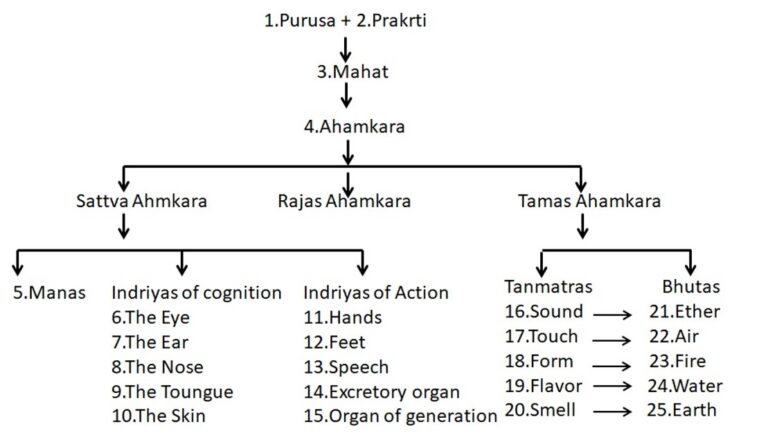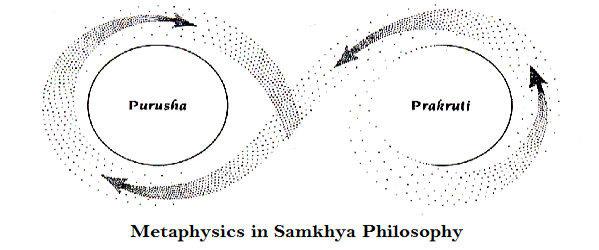- The name ‘Samkhya’ or ‘Sankhya’ literally means ‘Enumeration’.
- It was given by Maharashi Kapila.
- It has 25 principles.
- Sankhya philosophy explains the principle of cosmic evolution by rational analysis.
- Samkhya is the oldest of the orthodox philosophical schools, and it holds that everything, in reality, is derived from Purusha (self, soul, or intellect) and Prakriti (matter, creative agency, energy)
Purusha: unchangeable also known as universal spirit, soul, the self, pure consciousness.
Prakrati: prakriti is that which is created, it is cosmic substance which produces whole of manifested universe including its psychic phenomenon.
It is the basic cosmic material that is the root of all beings.
Prakriti evolves in response to purusha and its internal elements changes further leading to the formation of panchmahabhutas
Phases of Development
- According to this school, Purusha impinges on Prakriti, much like a magnet attracts iron shavings to itself, and the process of development starts. Prakriti is the first and foremost basis of evolution and this evolution takes place due to presence of purusha.
- Prakriti is changeable part of universe.
- Purusha, which was previously pure consciousness without an object, gets focused on Prakriti, from which buddhi (“spiritual awareness”) emerges. The next stage of evolution is individualistic ego consciousness (ahamkara, “I-consciousness”),
The Ahamkara is further subdivided into five gross elements (space, air, fire, water, earth), five fine elements (sound, touch, sight, taste, smell), five organs of perception (to hear, touch, see, taste, smell), five organs of activity (to talk, grip, move, procreate, expel), and consciousness (as coordinator of sense impressions). The whole universe is the outcome of all these principles, in different combinations, to which the Purusha is added.


The whole of prakriti or nature is constituted of the three gunas, satva, rajas and tamas, and the Lord is the creator and controller of these.
Sankhya Philosophy states that nature is constituted by three gunas:
- Sattva – principle of pleasure.
- Rajas – principle of activity.
- Tamas – principle of passivity.
Sattva
Sattva is that element of Prakriti which is of the nature of pleasure. Something that ignites, illuminates and causes comfort to the person who needs that nature. Satisfaction, happiness, joy, pride are produced in our own mind through the operation and manifestation of “Sattva” guna.
Rajas
Rajas is the principle of activity, this is the guna which makes things move from one state to another state. Eg. If the ignition of fire is termed as “Sattva”, Rajas is the spreading of fire.
It is because of the presence of Rajas guna everything moves. The wind blows, the fire spreads and the mind becomes restless. In short, Rajas is the component which is responsible for motion.
Tamas
Tamas is the principle of passivity. Tamas is the component which resists Sattva and Rajas. The Tamas component in an individual or object produces ignorance, darkness, laziness, confusion, apathy.
Balance is thus a comination of “Sattva”, “Rajas” and “Tamas”. These three gunas always go together and can never be separated from one another. One guna cannot produce anything without the co-operation of the other two gunas. All the three gunas are present in every single thing in this world, from big to small, from fine to gross.
The nature of an object is determined by the predominant guna, at any given instance of time and situation.


Thank you sir
You are welcome 🙂